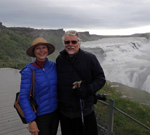  Seattle | On Our Way | Kyoto | Nara | Gobi | Ulaanbaatar | Irkutsk | Lake Baikal | Moscow-1 | Moscow-2 Spitsburgen Cruise | Iceland | Greenland | Boston | Reprise of Northern Summer Trip | On Second Thought |
  Seattle | On Our Way | Kyoto | Nara | Gobi | Ulaanbaatar | Irkutsk | Lake Baikal | Moscow-1 | Moscow-2 Spitsburgen Cruise | Iceland | Greenland | Boston | Reprise of Northern Summer Trip | On Second Thought |
NARA June 13, 2015 Nara is about an hour away from Kyoto by bus. Going there meant that we were going to see more temples or shrines. You might reasonably ask — why bother? I guess the answer lies in the realization that if you are not going to a place to look at some natural wonder or going shopping, you can look at how the populace lives today and how they got that way. The latter focus means that you need to know how the early peoples of the area (mostly rulers or others in power) lived, worshiped, and died.
The early rulers of Japan had their capitals in several parts of Japan, including Kyoto and Nara. Buddhism and Shinto are the two principal religions of Japan and have been for centuries and their places of worship are of great interest. These two represent about 75% or more of the religions of the country and most persons belong to both. Shinto is the religion that people use to celebrate life changing events; births, weddings, buying a new car, and so forth. But, people choose to be buried as Buddhists.
As with the Shinto Temple in Koyto, we witnessed a wedding but were not witnesses to a car blessing as we were in Koyto. We then went on to the Todaiji Temple, the home of the Daibutsu Buddha, the world's
After a traditional Japanese-style lunch of Shabu-shabu, Carol and I split to go to different places. I went to Nijo Castle, the site of the famous nightingale floors. The fortress was the home and office of the Shogun. His early warning system (against the Ninja) was that the floors creaked deliberately. The creaks sound like birds chirping. The layout of the palace-fort was similar to those with similar function found in China and the Islam world. The surrounding gardens were spectacular.
Dinner was on our own. The problem with most tours is that they want to introduce you to local cuisine but have to do so with lots of people all at once and on a schedule. It's cafeteria-style food that has the shape of the local dishes. You may recall the poem that has the line something like; "for want of a nail, the Kingdom was lost". Well, the failure to test the IT system on the plane in advance of departure from Seattle so that the lecturers could entertain us using our fancy new Ipads made a very long flight seem longer. To make up for the fact that we did not hear the lectures on the places in Japan we would be visiting, we heard the lectures on what we'd visited just on the eve of departure. That meant that all of the trips for the last day in Japan were rushed and dinner had to be delayed. The lectures were ok. Dinner was superb. We had Italian in Japan. Not standard fare but as good a meal as I have had anywhere.
|